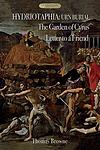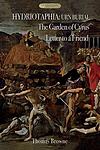Sir Thomas Browne
Sir Thomas Browne was a 17th-century English polymath and author of varied works that reveal his wide learning in diverse fields including science and medicine, religion and the esoteric. His writings display a deep curiosity towards the natural world, the human condition, and the obscure. Notable works include 'Religio Medici' (The Religion of a Doctor) which expresses his personal spiritual beliefs and philosophical reflections, and 'Hydriotaphia, Urn Burial,' a meditation on death and the vanity of human aspirations.
Books
This list of books are ONLY the books that have been ranked on the lists that are aggregated on this site. This is not a comprehensive list of all books by this author.
-
1. Religio Medici
"Religio Medici" is a deeply personal essay that explores the author's spiritual beliefs and philosophical thoughts on religion and medicine. Written in the 17th century, the text delves into the author's reflections on the nature of faith, the relationship between science and religion, and the practice of medicine as a spiritual calling. The author argues for a rational and tolerant approach to religious understanding, advocating for the coexistence of scientific inquiry and religious faith. The work is known for its eloquent prose and the introspective examination of the author's own beliefs and experiences, offering a unique insight into the intellectual landscape of the time.
-
2. Hydriotaphia, Urn Burial
"Hydriotaphia, Urn Burial" is a reflective, philosophical work exploring mortality, the inevitability of death, and the human struggle to understand the universe. The author delves into the customs and rituals of different cultures surrounding death and burial, using the discovery of ancient burial urns as a starting point. The text is a profound meditation on death, the fleeting nature of life, and the human desire for immortality. It also explores the mysteries of the universe, the limits of human knowledge, and the uncertainty of life after death.
-
3. Hydriotaphia, Or Urne Buriall
The book in question is a meditative reflection on mortality, the rituals of burial, and the human desire for remembrance. Written in the 17th century, it explores the discovery of ancient funeral urns in England, prompting the author to delve into a wide-ranging philosophical discourse on death and the ephemeral nature of life. The text is known for its rich, baroque language and the author's erudition, as it weaves together historical accounts, classical scholarship, and theological musings. The work ultimately serves as a contemplation on the vanity of human aspirations and the inevitable obscurity that time imposes on all human endeavors.
-
4. The Garden Of Cyrus
"The Garden of Cyrus" is a discursive, esoteric essay that delves into the symbolism and philosophy of the number five, particularly as it appears in nature and art. The work explores the quincunx pattern, which is a geometric arrangement of five points with four forming a square or rectangle and the fifth at its center. The author traverses a wide range of subjects, including the design of gardens, the structure of plants, ancient history, and the visual arts, to illustrate the recurrence and significance of this pattern throughout the natural world and human culture. The essay is known for its rich, elaborate prose and the breadth of its intellectual curiosity, reflecting the author's deep engagement with the mysteries of the cosmos and the search for underlying order in the chaos of existence.



